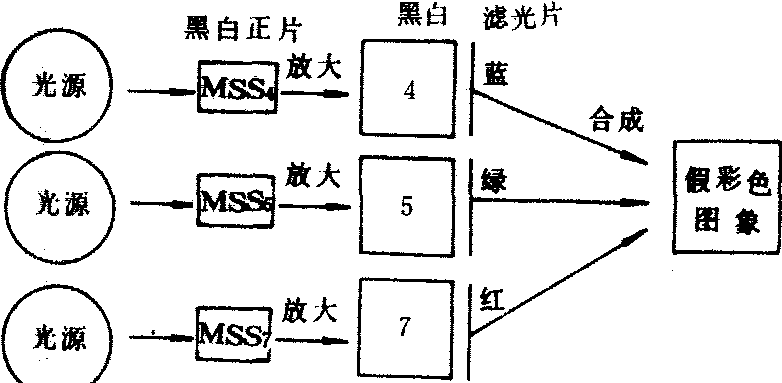彩色合成caise hecheng
即多波段图象的彩色合成。它是把同一地区不同波段的黑白图象,通过不同的滤光片,使其影像准确地重合投影在同一个屏幕上,而形成假彩色图象(如图)经过合成后的图象可以大大地提高图象的易读性,因为人眼对彩色物体的分辨能力,要比黑白物体的分辨能力高得多。实验证明,人眼对黑白的灰度变化,最多能识别10级,而对于颜色至少能识别100种以上。进行彩色合成时,通过不同光谱段底片、滤光片、瀑光时间的变化,可以分别对各种不同地物获得良好的解译效果。在这方面我国部分高等院校教师和山西省合作创造了很好的经验。他们对于适合地质、地貌、水系、植被、土地利用以及古河道等不同解译要求,选择了不同的彩色合成方案,取得了良好的效果。例如,为了解译地质图,采用了MSS5、7波段组合方案,使图象上植被覆盖信息全部被消除,反映了微地貌和水系,有利于岩性和地质构造的解译;对于水系和水库的解译,采用MSS4、6、7波段的组合方案,把有水河道和无水河道及水面的信息特征提取了出来; 土地利用解译采用MSS4、5、6、7波段五次曝光的组合方案,能把山区小块耕地清楚地显示出来,铁路也能辨认。采用MSS4、6波段的组合方案,居民地轮廓显示得相当清楚。

彩色合成color composite
根据三原色原理,经过色光分解和合成,获得物体彩色图像的过程。即分别谱段对同一地面景物摄影或扫描得到的黑白正片(通常用3个谱段黑白正片),分别配以3种颜色的滤光片,经光学系统进行重叠投影,形成彩色图像。如果采用红、绿、蓝3个谱段的黑白正片,通过相应3色滤色片重叠投影,所得到的彩色图像与原地景物色彩一致,称为真彩色合成。如果改变各谱段的正片与滤光片间的组合,能产生各种彩色图像,影像色彩与原景物色彩不一致,称为假彩色合成。